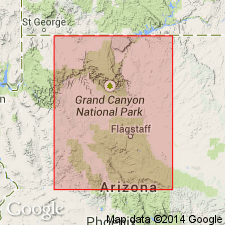
- Usage in publication:
-
- Sanup Plateau member
- Modifications:
-
- Original reference
- Dominant lithology:
-
- Limestone
- Siltstone
- Sandstone
- AAPG geologic province:
-
- Plateau sedimentary province
Summary:
Pg. 14 (fig. 1), 29, 90-92. Sanup Plateau member of Muav formation of Tonto group. At Meriwitica section, member consists of thick-bedded dark-gray aphanitic limestone with prominent bands of siltstone that weather red-brown. Farther west, at Quartermaster Canyon, Rampart Cave, and elsewhere, the same type of lithology prevails, but eastward and southward algal limestone dominates the facies. Thickness moderately uniform across area but becomes progressively thinner near its eastern and southern margins. Average thickness about 25 or 30 feet. Older than Spencer Canyon member (new); younger than Rampart Cave member (new). Age is Middle Cambrian, based on stratigraphic position.
Designation, Sanup Plateau, comes from large promontory of that name in western Grand Canyon, [Mohave Co., northwestern AZ]. Lower of two thin but persistent cliff-forming units that extend through the western two-thirds of Grand Canyon between slope-forming tongues of shale and other weak sediments.
Source: US geologic names lexicon (USGS Bull. 1200, p. 3473); supplemental information from GNU records (USGS DDS-6; Menlo GNULEX, Denver GNULEX), GNC index card files.
For more information, please contact Nancy Stamm, Geologic Names Committee Secretary.
Asterisk (*) indicates published by U.S. Geological Survey authors.
"No current usage" (†) implies that a name has been abandoned or has fallen into disuse. Former usage and, if known, replacement name given in parentheses ( ).
Slash (/) indicates name conflicts with nomenclatural guidelines (CSN, 1933; ACSN, 1961, 1970; NACSN, 1983, 2005, 2021). May be explained within brackets ([ ]).

